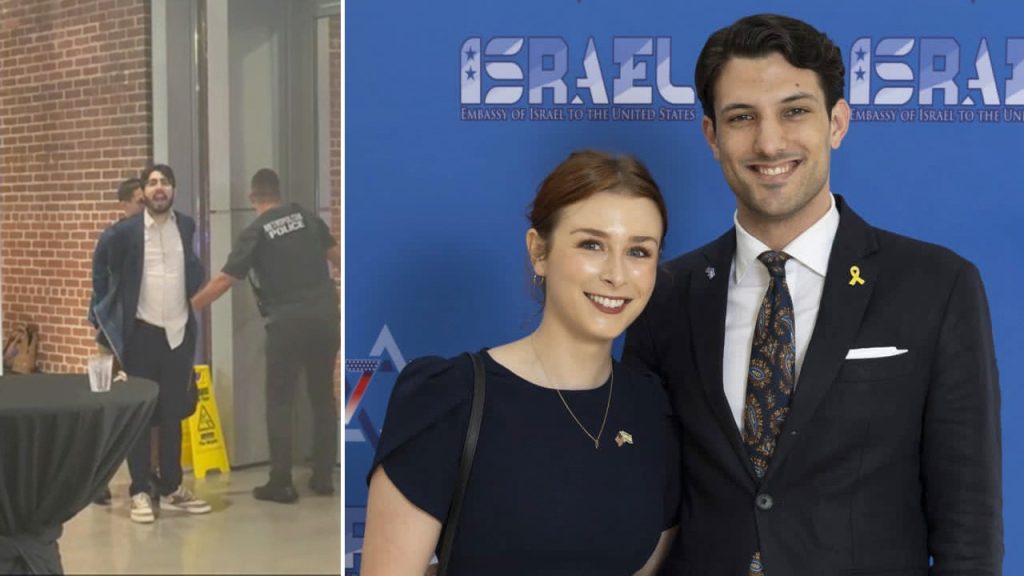In a shocking incident on May 21, 2025, two staffers from the Israeli Embassy in Washington, D.C., were fatally shot outside the Capital Jewish Museum. The suspect, identified as 30-year-old Elias Rodriguez from Chicago, reportedly expressed his motives linked to the Israeli-Palestinian conflict during the attack. As details emerge, the ramifications of this tragic event are stirring widespread concern and condemnation among officials and communities.
| Article Subheadings |
|---|
| 1) Overview of the Shooting Incident |
| 2) The Suspect’s Background |
| 3) Eyewitness Accounts |
| 4) Reactions from Officials and Organizations |
| 5) Implications of the Incident |
Overview of the Shooting Incident
The tragic shooting took place outside the Capital Jewish Museum as guests were leaving an event. The victims, identified as Yaron Lischinsky and Sarah Milgrim, were reportedly on the verge of getting engaged. Eyewitnesses described a chaotic scene, with gunfire erupting suddenly as the two Israeli embassy staffers exited the building. Initial reports indicate that Rodriguez acted alone and had been pacing outside the museum before approaching the couple and opening fire.
Shortly after the first shots were fired, Metropolitan Police Department Chief Pamela Smith confirmed the arrest of Rodriguez at the scene. “We believe that he acted independently,” she stated, while confirming that a handgun was recovered by law enforcement officials.
The Suspect’s Background
Rodriguez, having worked for the American Osteopathic Information Association, had a profile that raised eyebrows following the attack. His social media history and previous employment suggested he had previously engaged in activism centered on social issues. After the arrest, reports revealed that Rodriguez had held roles including logistics coordinator and researcher, showcasing a diverse career path before the incident.
His LinkedIn profile, though later deactivated, indicated an academic pursuit with a Bachelor’s degree in English from the University of Illinois at Chicago. Previously, he had also worked with a nonprofit organization focusing on African American history, underscoring a seemingly deep commitment to social issues, though with an increasingly troubling divergence into violent activism.
Eyewitness Accounts
Katie Kalisher, an eyewitness present at the museum during the shooting, recounted a chilling interaction with Rodriguez just before his arrest. “He was visibly distressed and covered in rain… he asked for someone to call the police,” she recalled. The tension heightened as Rodriguez allegedly shouted, “Free, Free Palestine!” after pulling a traditional kaffiyeh from his bag, suggesting a direct motivation linked to political ideologies rather than random violence.
Kalisher’s account illustrates the unpredictable nature of the incident, transforming a cultural event into a site of tragedy and violent expression. The atmosphere was one of shock, as attendees witnessed firsthand the unfolding chaos, while Rodriguez’s final moments of freedom drew alarming parallels to motivated extremism.
Reactions from Officials and Organizations
The shooting has drawn swift condemnation from various leaders and organizations around the world. President Trump expressed outrage over the senseless violence, and Israeli officials referred to the incident as a direct attack on their nation’s representation within the United States. Spokespersons emphasized the need for heightened security measures at cultural and diplomatic events following this tragedy.
In a joint statement, the American Osteopathic Association extended sympathies to the victims’ families while expressing sorrow over the involvement of an organization employee in such a heinous act. “We stand ready to cooperate with the investigation,” the statement noted, underlining the broader implications of violence for communities and the ethical responsibilities of organizations in such circumstances.
Implications of the Incident
This tragic shooting underscores the tensions surrounding political and cultural identity in today’s society. Analysts believe that incidents like these can further polarize communities already divided over political issues. The implications extend beyond this event, with calls for additional dialogue on addressing extremist ideologies and hate crimes simplistically framed as political disagreements.
As various advocacy groups respond, emphasizing a path toward understanding and reconciliation, the ramifications of Rodriguez’s actions may serve as a catalyst for broader discussions on safety, free expression, and the rights of individuals to express political dissent without resorting to violence.
| No. | Key Points |
|---|---|
| 1 | Rodriguez shot two Israeli embassy staffers outside a cultural event. |
| 2 | He was arrested at the scene after admitting involvement and expressing anti-Israel sentiments. |
| 3 | Eyewitnesses reported chaos and distress, highlighting the unpredictability of such violent acts. |
| 4 | Officials and organizations expressed outrage and concern over the implications of the shooting. |
| 5 | The incident is viewed as a potential catalyst for discussions on extremism and community polarization. |
Summary
The shooting of two Israeli Embassy staffers in Washington, D.C., by Elias Rodriguez marks a pivotal incident in the ongoing discourse surrounding extremism, violence, and social issues. As the investigation unfolds, the community grapples with the implications of this tragedy—raising essential questions about safety, discourse, and the spectrum of political expression. It serves as a stark reminder of the potential consequences of rising tensions and highlights the need for introspection and dialogue across communities.
Frequently Asked Questions
Question: What led to the shooting incident involving the Israeli embassy staffers?
The shooting appears to be linked to Elias Rodriguez’s expressed anti-Israel sentiments, indicated by his statements during the incident.
Question: How are officials responding to the attack?
Officials, including political leaders and organizations, have condemned the shooting and expressed concern about the safety of cultural and diplomatic events.
Question: What can be expected in the aftermath of this tragedy?
In the wake of this incident, discussions surrounding extremism, community response to violence, and the broader implications for diplomatic representation are anticipated to take center stage.



